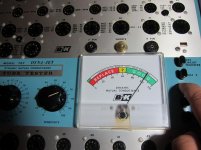On several newer type B&K tube testers (707 747), the full scale reading is numbered 120. And mid scale being 60. So 82 is up in the green (good) area of the meter.
Attachments
Last edited:
On several newer type B&K tube testers (707 747), the full scale reading is numbered 120. And mid scale being 60. So 82 is up in the green (good) area of the meter.
A belated thanks for the reply.
On an a B&K 707 mutual conductance test on a proverbial NIB GEC kt88, what would the reading be on the meter?
Thanks
If you look at the datasheet for a KT88 you will see the average transconductance for a specific operating point is 11.5mA/V, or 115 micromhos. For the mutual conductance tester you have they might have a different operating point but still 120 is close to the 115 in the datasheet. You will want a new tube to test around this 120 mark in your tester.
So in short you want the meter to read 120 for a new tube.
So in short you want the meter to read 120 for a new tube.
If that were how this tester worked, then a lower gm tube would test as "bad". Since I have a 707, I can say that it is more of a percentage scale, allowing 20% overage for a particularly strong tube. The sensitivity is set according to the type of tube being tested. So, to answer the question, 100 or better would be ideal. In practice, with mostly used tubes, I have found very few test above 100, but many around 80-90.
Ahh I see, it goes by percentage. I will guess that its not a very a accurate tester and "good" or "replace" is all you get.
To correct my earlier post it would be 11,500 microhms.
To correct my earlier post it would be 11,500 microhms.
- Status
- Not open for further replies.
- Home
- Amplifiers
- Tubes / Valves
- KT88 Mutual Conductance Test
